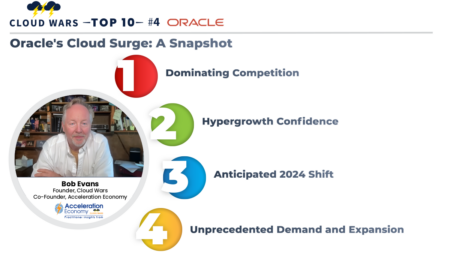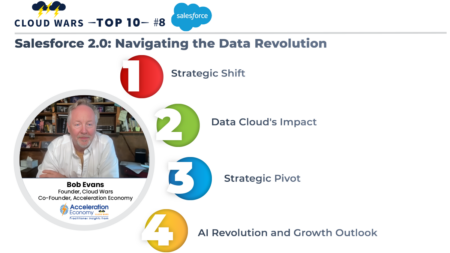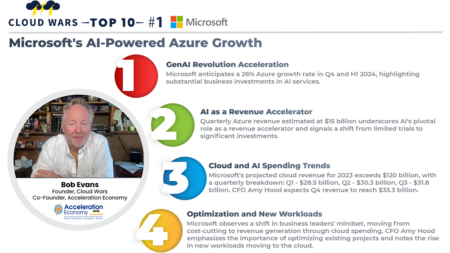Tyler Predale shares how Flashpoint uses Gemini AI to enhance productivity, streamline tasks, and empower employees across departments.
Search Results: growth (2814)
The rise of SAP over Salesforce in market cap underscores the shifting dynamics within enterprise software, the cloud, and AI.
AWS is expected to achieve or exceed a 17.2% growth rate in Q2, driven by robust demand for GenAI and its other AI services including Bedrock and SageMaker.
With an expected 29% growth rate, Oracle would outpace Google Cloud as the fastest-growing cloud provider, driven by strategic innovations in infrastructure, databases, and enterprise applications.
Salesforce’s Q1 revenue growth hit 11%, but a forecast of 8-9% fiscal-year growth caused a sharp market cap drop due to concerns over declining customer spending and future growth challenges.
Challenges and opportunities emerge as Salesforce shifts focus from growth to profitability. This transition marks a significant evolution and raises a number of strategic questions.
Raj Datta shares insights on the latest innovations from IBM that enable partner evolution, advance co-creation, and foster customer growth.
Erica Volini shares top takeaways from Knowledge24, spanning record attendance, key partnership announcements, and the overarching theme of AI.
The ServiceNow Knowledge Event provides a platform for thought leaders to explore pioneering visions, strategic collaborations, and the practical implementation of AI in real-world scenarios
In Q1, AWS has had a reaccelerating of its growth rate; Andy Jassy offers several reasons for this movement.
Google Cloud’s potential growth trajectory amid the infusion of AI into cloud services indicates a significant shift in the cloud + AI competitive dynamics.
During the SAP Q1 earnings call, CEO Christian Klein and CRO Scott Russell highlighted key factors in the growth of the Cloud ERP Suite.
Oracle’s Q3 results reveal both challenges in meeting cloud infrastructure demand and ongoing success in securing large deals.
Oracle is expected to deliver a 51% increase in Q3 cloud-infrastructure revenue, underlining its prowess in attracting major clients and reshaping industry dynamics.
Salesforce CEO Marc Benioff declares the company’s transformation into a data company amid slowing growth projections for its core business.
Workday accelerates innovation, experiencing substantial growth in applications through strategic partnerships, and the launch of an AI marketplace.
Accenture and Celonis showcase the success and strategic growth of their partnership at Celosphere 2023.
AI tools, such as Microsoft Copilot, ChatGPT, and Google Bard, now play a crucial role in software development and IT careers more broadly.
Microsoft anticipates a 26% to 27% growth rate for Azure in 2024, driven by substantial AI investments, and quarterly cloud revenue should top $33 billion.
Microsoft’s positive 2024 outlook emphasizes AI’s crucial role in sustaining Azure’s growth.





















